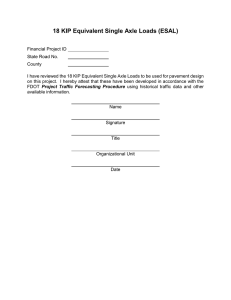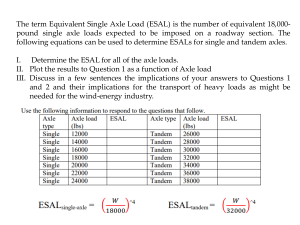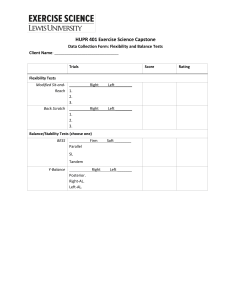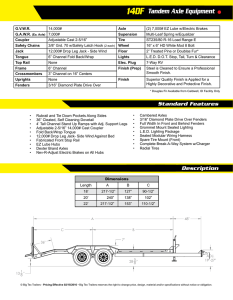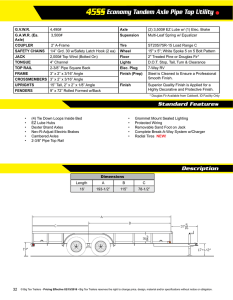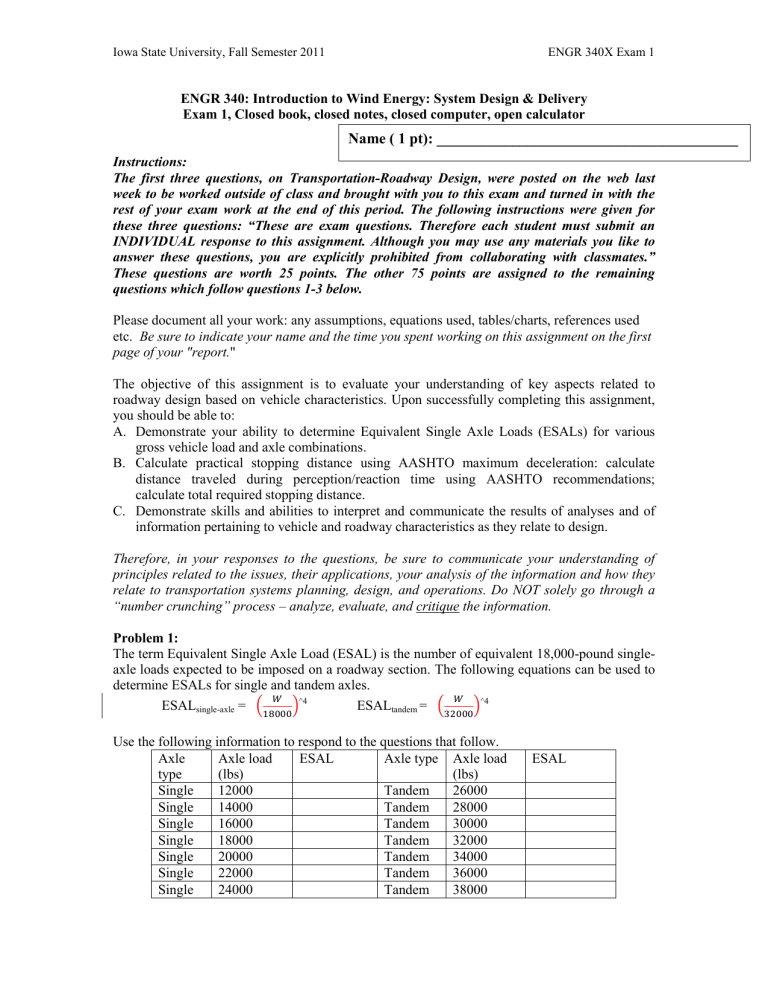
Iowa State University, Fall Semester 2011 ENGR 340X Exam 1 ENGR 340: Introduction to Wind Energy: System Design & Delivery Exam 1, Closed book, closed notes, closed computer, open calculator Name ( 1 pt): ________________________________________ Instructions: The first three questions, on Transportation-Roadway Design, were posted on the web last week to be worked outside of class and brought with you to this exam and turned in with the rest of your exam work at the end of this period. The following instructions were given for these three questions: “These are exam questions. Therefore each student must submit an INDIVIDUAL response to this assignment. Although you may use any materials you like to answer these questions, you are explicitly prohibited from collaborating with classmates.” These questions are worth 25 points. The other 75 points are assigned to the remaining questions which follow questions 1-3 below. Please document all your work: any assumptions, equations used, tables/charts, references used etc. Be sure to indicate your name and the time you spent working on this assignment on the first page of your "report." The objective of this assignment is to evaluate your understanding of key aspects related to roadway design based on vehicle characteristics. Upon successfully completing this assignment, you should be able to: A. Demonstrate your ability to determine Equivalent Single Axle Loads (ESALs) for various gross vehicle load and axle combinations. B. Calculate practical stopping distance using AASHTO maximum deceleration: calculate distance traveled during perception/reaction time using AASHTO recommendations; calculate total required stopping distance. C. Demonstrate skills and abilities to interpret and communicate the results of analyses and of information pertaining to vehicle and roadway characteristics as they relate to design. Therefore, in your responses to the questions, be sure to communicate your understanding of principles related to the issues, their applications, your analysis of the information and how they relate to transportation systems planning, design, and operations. Do NOT solely go through a “number crunching” process – analyze, evaluate, and critique the information. Problem 1: The term Equivalent Single Axle Load (ESAL) is the number of equivalent 18,000-pound singleaxle loads expected to be imposed on a roadway section. The following equations can be used to determine ESALs for single and tandem axles. ESALsingle-axle = ( )^4 ESALtandem = ( )^4 Use the following information to respond to the questions that follow. Axle Axle load ESAL Axle type Axle load type (lbs) (lbs) Single 12000 Tandem 26000 Single 14000 Tandem 28000 Single 16000 Tandem 30000 Single 18000 Tandem 32000 Single 20000 Tandem 34000 Single 22000 Tandem 36000 Single 24000 Tandem 38000 ESAL Iowa State University, Fall Semester 2011 ENGR 340X Exam 1 1. Determine the ESAL for all of the axle loads. 2. Plot the results to Question 1 as a function of Axle load 3. Discuss in a few sentences the implications of your answers to Questions 1 and 2 and their implications for the transport of heavy loads as might be needed for the wind-energy industry. Each question is worth 4 points Problem 2 (7 points): A vehicle manufacturer is considering an engine for a new sedan (CD = 0.30, Af = 21 ft2). The car is being designed to achieve a top speed of 100 mi/h on a paved surface at sea level (ρ = 0.002378 slugs/ft3). The car currently weighs 2,100 lb, but the designer initially selected an underpowered engine and did not account for aerodynamic and rolling resistances. If 2 lb of additional vehicle weight is added for each unit of horsepower needed to overcome the neglected resistance, what will be the final weight of the car if it is to achieve the 100 mi/h top speed? Problem 3 (6 points): An engineering student claims that a country road can be safely negotiated at 70 mi/h in rainy weather. Because of the winding nature of the road, one stretch of level pavement has a sight distance of only 590 ft. Assuming practical stopping distance, comment on the student’s claim. Problem 1 ESALsingle-axle = (W/18000) 4 ESALtandem-axle = (W/32000)4 Axle type Single Single Single Single Single Single Single Tandem Tandem Tandem Tandem Tandem Tandem Tandem Axle load (lbs) 12000 14000 16000 18000 20000 22000 24000 26000 28000 30000 32000 34000 36000 38000 Single ESAL Tandem ESAL 0.198 0.366 0.624 1.000 1.524 2.232 3.160 0.436 0.586 0.772 1.000 1.274 1.602 1.989 3.500 Single ESAL 3.000 Tandem ESAL ESAL 2.500 2.000 1.500 1.000 0.500 0.000 Axle Load (lbs) OR 3.500 3.000 Single ESAL Tandem ESAL 2.500 Tandem ESAL ESAL 2.500 2.000 1.500 1.000 0.500 0.000 Axle Load (lbs) As axle loads increase their impacts on the pavement increase in a non-linear (exponential) manner. For example, a 22,00 lb single axle load has about 7 times the impact of a 24,000 lb tandem axle load. Therefore, for the transport of heavy loads, in order to minimize the impacts of axle loads on the pavements, the transport vehicles should use tandem axles instead of single axles, and have as many axles as needed to keep the per axle load to be as small as possible (~18,000 lb for single axle, and 32,000 lb for tandem axle). Iowa State University, Fall Semester 2011 ENGR 340X Exam 1 ====================================================== In-class exam section ====================================================== Problem 4 (20 pts): The following data may be needed for this problem. 1 Quad=1×1015BTU; 1 MWhr=3.412MMBTU. a. (7 pts) What is the wind power generating capacity, in GW, which is necessary to produce 8 Quads of electric energy? Assume a 0.35 capacity factor for the wind and lossless conversion. Solution: 1 1015 BTU MMBTU MWhr 2.3447 10 9 MWhrs 6 Quads 1 10 BTU 3.412MMBTU So we will obtain 2.3447E9 MWhrs from wind. We need to know what is the wind power capacity to generate 2.3447E9MWhrs? 8Quads As indicated in the problem statement, we assume that this energy is the energy produced by the wind plant since “lost” wind energy (even that lost in the wind energy generator) is free. To get that, we use our capacity factor of 0.35 to obtain Pcapacity=2.3447E9/(0.35*8760)=764730MW=764.7GW. b. (7 pts)What is the nuclear power generating capacity, in GW, which is necessary to use 8 Quads of uranium input energy? Assume a 0.95 capacity factor for the nuclear and a heat rate of 9.5MMBTU/MWhr. Solution: 1 1015 BTU MMBTU MWhr 8Quads 0.84211 10 9 MWhrs 6 Quads 1 10 BTU 9.5MMBTU So we will obtain 0.84211E9 MWhrs from nuclear. We need to know what is the nuclear power capacity to generate 0.84211E9MWhrs? As indicated in the problem statement, we assume that this energy is the energy input to the nuclear generating plant. To get this, we use our capacity factor of 0.95 to obtain Pcapacity=0.84211E9/(0.95*8760)=101190MW=101.2GW. c. (6 pts) Jack looks at the above calculations and makes the following comment: “The nuclear option is clearly a much better option because it is able to handle its 8 Quads with less capacity.” If we ignore the issues of nuclear safety and nuclear waste storage, what do you think Jack is not considering in making his assessment? Solution: The 8 Quads is input energy. In terms of output energy, the wind option would produce over twice as much as the nuclear option. Iowa State University, Fall Semester 2011 ENGR 340X Exam 1 The wind option is significantly less expensive to build on a $/MW basis. The wind option requires very little additional O&M expense through its lifetime, whereas the nuclear requires a continuous fuel expense. Problem 5 (15 points): For the following electricity market data, plot the supply and demand schedules, and determine the market clearing price. Assume that solutions having multiple possible clearing prices are always settled in favor of buyers. Determine, at the market clearing price, the buyers’ surplus, the sellers’ surplus, the total surplus, and the wind energy owner’s (W1) surplus. Offers to sell 1MWhr Bids to buy 1MWhr Order of S1 S2 W1 B1 B2 B3 offer or 1 $10.00 $10.00 $5.00 $80.00 $70.00 $20.00 bid 2 $40.00 $40.00 $10.00 $80.00 $50.00 0 3 $50.00 $60.00 $20.00 $70.00 $20.00 0 4 $60.00 $70.00 ∞ $60.00 0 0 5 ∞ ∞ ∞ 0 0 0 6 ∞ ∞ ∞ 0 0 0 7 ∞ ∞ ∞ 0 0 0 Solution: Offer/bid order 1 2 3 4 5 6 7 8 9 10 11 Offers to sell 1 MWhr Seller Price W1 $5.00 W1 $10.00 S1 $10.00 S2 $10.00 W1 $20.00 S1 $40.00 S2 $40.00 S1 $50.00 S2 $60.00 S1 $60.00 S2 $70.00 Bids to buy 1 MWhr Buyer Price B1 $80.00 B1 $80.00 B2 $70.00 B1 $70.00 B1 $60.00 B2 $50.00 B2 $20.00 B3 $20.00 Iowa State University, Fall Semester 2011 ENGR 340X Exam 1 Price ($/MWhr) Quantity (MWhr) Market clearing price = $40/MWhr. Buyers surplus=$170.00. Sellers surplus=$145.00. Total surplus=$315.00. Wind energy owner’s surplus=$35+$30+$20=$85.00. Problem 6 (21 points): 1. The performance coefficient (Cp) curves for a wind turbine is given below. For this wind turbine, the blade diameter is 70 meters, and the gear ratio is 1:100 (turbine rpm to generator rpm). Assume the air density is ρ=1.225kg/m3. Also assume the rotational velocity of the generator is fixed at 1200 rpm and the pitch angle is fixed at θ=1°. The following information may be helpful to you. 1 mile=1609.344meters; Pin 1 At v13 ; 2 Pmax 8At v13 ; 27 P C p ( , ) Pin a. Determine the swept area. Solution: At=πr2=π(70/2)2=3848.5m2 b. Determine the rotational speed of the blades in rad/sec when the generator is at 1200rpm. Iowa State University, Fall Semester 2011 ENGR 340X Exam 1 Solution: With a gear ratio of 100:1, the rotational speed of the blades in rpm is 1200/100=12 rpm. Now convert to rad/sec: ω=12rev/min*(2πrad/rev)*(1min/60sec)=1.2567rad/sec c. Compute the wind speed in meters/sec when it is 10 mph. Solution: v1=(10miles/hr)*(1609.344meters/mile)*(1hr/3600sec)=4.47meters/sec. d. Compute the tip-speed ratio when the wind speed is 10 mph. Solution: λ=ωr/v1=(1.2567rad/sec)*(70meters/2)/(4.47meters/sec)=9.84 e. Estimate CP. Solution: From the above graph, using λ=9.84 and θ=1deg, CP≈0.47. f. Compute the power of the wind stream at 10mph. Solution: 1 (1.225kg / m 3 )(3848.5m 2 ) * (4.47m / sec) 3 3 Pin At v1 210.5kW 2 2 g. Compute the power output of the machine at 10mph. Solution: P C P Pin 0.47(210.5) 98.935kW Problem 7 (18 points): a) In the US, only four states in the top 10 wind capacity states have Pacific or Atlantic Ocean coastlines. Name three of these states. Solution: Any three of the following: California, Oregon, Washington, and New York. b) There are generally three ways that government has considered to influence supply-side energy-related behavior, that have had or would have significant influence on the growth of wind energy. Name these three ways. Solution: Renewable portfolio standards; Production tax credits; Imposing cost on environmental impact (CO2 tax or CO2 cap & trade system) c) Identify three out of the four “grand challenges” for wind energy. Solution: Any three of the below: 1. How to move wind energy from where it is harvested to where it can be used? 2. How to develop economically-attractive methods to accommodate increased variability and uncertainty introduced by large wind penetrations in operating the grid? 3. How to improve wind turbine/farm economics (decrease investment and maintenance costs, increase operating revenues)? Iowa State University, Fall Semester 2011 ENGR 340X Exam 1 4. How to address potential concerns about local siting, including wildlife, aesthetics, and impact on agriculture? d) Power systems implement four levels of MW control. Describe three of them in terms of their time frame and control objective. Solution: Any three of the below. Primary control: 1-20 second time frame, control objective is to maintain power balance and transient frequency. Secondary control or AGC: 4 second to 3 min time frame, control objective is power balance and steady-state frequency. Real-time market: every 5 minutes; control objective is power balance and economic dispatch. Day-ahead market: every day 24 hours at a time; control objective is power balance and economic–unit commitment. e) Assume that Iowa is a closed system, and that the peak load of Iowa has remained at about 8GW from 1990 until today. Since 1990, Iowa wind capacity has grown from 0 GW to about 4 GW in 2011. Assume during peak conditions, only about 20% of the wind capacity is produced. Compute the net load (MW) at peak conditions for year 1990 and for year 2011. Solution: 1990: Net Load = 8GW 2011: Net Load = 8GW-(4GW)*(0.20)=7.2GW Do you think that the maximum 10 minute net load (MW) variation that conventional (not wind) power plants have to compensate is greater in 1990 or greater in 2011? Solution: Greater in 2011. Do you think that the maximum 1 minute net load (MW) variation that conventional (not wind) power plants have to compensate is greater in 1990 or greater in 2011? Solution: Greater in 2011. Iowa State University, Fall Semester 2011 f) ENGR 340X Exam 1 Identify at least three ways to compensate MW variability: Solution: Any of the below are acceptable: Combustion turbines (or fast-ramping turbines) Some kinds of storage Demand control Increasing control area Control the wind
